
Determining Whether Your Property Resides in a Flood Zone: A Comprehensive Guide
“Am I in a flood zone?”
That’s a question many new or potential homeowners ask themselves. It’s especially important for folks who live or are moving to Gold Coast, NJ communities since certain areas are more prone to flooding and water emergencies.
If you’re worried about buying a house in a flood zone or wondering if environmental changes have impacted your current neighborhood, there are several resources that may provide answers.
Below, you’ll learn how to tell if your property is in a flood zone (and also FloodCo USA can help if you have a flood emergency).
Identifying Flood Zones With FEMA
One of the best resources for determining if your home or business is located in a flood zone is courtesy of the Federal Emergency Management Agency (FEMA).
FEMA’s website features an invaluable tool resource called the Flood Map Service Center.
When you enter the address of your home or business in the search bar of this user-friendly tool, FEMA will provide you with a map and detailed information regarding your locations flood risks.
How To Use A FEMA Flood Map
At first sight, the flood maps and information provided by your search may cause more questions than answers. That’s because it does use some terminology and abbreviations that are unfamiliar to most people.
The good news is that FEMA knows this. That’s why they support their map and information with an easy-to-understand glossary that explains some of the more complex terminology.
Better than that, FEMA also provides visitors with a simple Flood Zone chart. This straightforward chart lists zones alphabetically and offers a breakdown of each zone’s flood risks.
Essentially, the various flood zones can be summarized as follows:
- Zone A – They are several Zone A classifications for properties. All of them pertain to locations that have non-coastal related flood hazards such as lower elevations or properties near dams, levees or streams.
- Zone B – Homes or businesses in this zone are considered at moderate risk for flooding.
- Zone C – FEMA has determined that properties in this zone are at minimal risk of flooding.
- Zone D – Properties in this zone are at a possible risk of flooding. However, there is not enough information to determine how great the extent of the flooding could be.
- Zone V – This zone destination refers to coastal areas where properties are at extremely high risk of flooding.
- Zone X – This is a new zone designation that will eventually supersede Zone B and Zone C classifications. This new zone is actually split into two different categories: Zone X -Shaded – Areas with moderate flood risks Zone X Unshaded – Areas with minimal flood risks
In addition to providing you and other property owners with information about flood risks, these maps are also used by insurance providers to determine a property’s respective flood insurance needs and premiums.
Since floods, construction and other factors can impact the flood risks of specific areas, the information these maps provide is often in flux. To make sure you’re fully aware of your property’s flood risks, we recommend visiting the FEMA Flood Map Service Center several times a year.
What To Do If Your Property Is Flooded
While FEMA flood maps are a great resource for assessing potential flood risks, they are also reminders of one very important piece of information:
Floods can damage any home or business regardless of its location.
While some areas are at greater risk of flooding, all areas can experience flooding. Severe storms occur everywhere, so no property is ever risk-free. That’s why it’s always a good idea to have a plan in place in case your property is impacted by a flood.
The first step you need to take if your home or business is flooded is to ensure the safety of you and everyone in your property.
The next is to call the flood damage specialists at FloodCo USA!
Our teams of certified technicians apply their experience, knowledge and specialized equipment to quickly pump out flood waters and effectively dry out your property. And they can accomplish these goals without ripping and removing your walls and floors.



